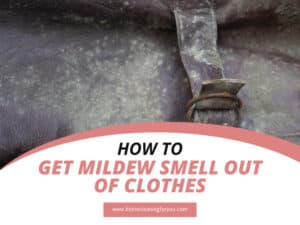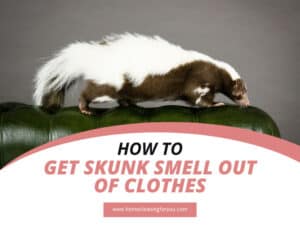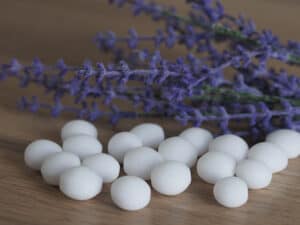How to Remove Stubborn Sour Smell from Your Clothes

Understanding how to get sour smell out of clothes is no easy task.
One of the things I like to do the most is to sniff the clothes after drying and just inhale all that fresh, flowery scent from newly-washed clothes. So you can tell how frustrating it would be if all I can smell from them is a musty, sour odor.
This smell just lingers on your clothes all day, sometimes it can be so strong that others can smell it too. The worst thing is, they might think it’s your body odor. How embarrassing can that be!
Dealing with this sort of smell requires more attention than you think. A simple wash is not enough to completely remove the smell, it just covers it. However, with the right techniques and products, you will be able to handle this problem like a pro. Let’s dive right in!
The Cause Of Sour Smell In Clothes
The sour smell in clothes usually comes from mildew. Mildew is a type of fungus which grows in warm, damp environments. They can form quickly in places like your washer or the bottom of your laundry basket.

Not only does mildew make the clothes smell bad, but it can also be harmful to your health.
Those with asthma, respiratory diseases, or immune disorders, as well as the very young and elderly, may experience symptoms such as wheezing, coughing, or itchy eyes (1).
Another common cause of sour smell in clothes is sweat. This is the reason why people often find this smell in their workout garments or towels.
Despite common belief, sweat doesn’t smell. The sour odor is caused by bacteria and apocrine gland secretions. The longer the sweat sits in clothes, the stronger the odor.
So, after coming home from the gym, wash your clothes right away to prevent this. Also, do not leave it in the laundry basket along with other clothes because the bacteria and smell can spread to other items.
Everyday Products That Can Remove Sour Smell
Sour smell can be simply removed using products that you probably already have in your house. These familiar items are more powerful than they seem and they can handle problems that your regular detergent can’t.
| Product | Pros | Cons |
| Vinegar | Suitable for standard and high-efficiency washersRemove odorsCheap and accessibleBrighten and whiten clothes | Low pH level of 2-3 (2)Can only work with mild odorVinegar with higher pH levels usually contains tannins that can stain clothes |
| Baking Soda | High pH level of 9 (3) Remove odorsCheap and accessibleBrighten and whiten clothes | Might not work well with colored clothingCan make clothes stiff and rough |
| Bleach | Remove odorsErase stains from clothes and whiten them | Cannot be used on clothes with color or synthetic fabricsCan be dangerous to work with |
| Sudsy Ammonia | Erase stains, whiten, and soft clothesRemove odorsCan be used on both whites and colors | Difficult to findCannot be used on clothes with synthetic fabricsCan be dangerous to work with |
| Vodka | Remove odorsCheap and accessibleQuick and easyWorks with non-washable items | Can only work with mild odorExcessive alcohol can have counterproductive effects. |
How To Remove Sour Smell From Clothes?
You may think a simple wash cycle would eliminate that all-too-familiar foul odor, but you’d be very, very wrong. It takes a bit of work and time to get rid of it completely, but the lucky news is that you can do so using products you already have in your house.
Step 1: Sort Your Clothes

Separate lights and darks as well as delicate fabrics and tougher ones. Since you will be using hot water to effectively remove the smells, it might damage delicate clothes.
Step 2: Put The Clothes In The Machine

Do not overcrowd your washing machine. Divide them into 2 or even 3 loads so they can get cleaned thoroughly.
Step 3: Add Vinegar And Detergent (Or Bleach)

Pour 2 cups of distilled white vinegar into the detergent dispenser drawer. Remember to use the white type (I use the one with 5% acidity) because the yellow one can stain your clothes. Then add the laundry detergent that you always use.
Additionally, for white garments, you can replace vinegar with chlorine bleach (¾ cup) as a more effective alternative. It can also help whiten and brighten your clothes.
Step 4: Wash Them
Set the washing machine to the hottest water setting the material can withstand. Check the labels on the clothes carefully before washing.
Step 5: Use Baking Soda If Necessary

If your clothes still smell after washing, add ½ cup of baking soda along with your detergent of choice into the washer and give it another spin (using the same setting).
You can also add some vinegar into the rinse cycle after washing the clothes with baking soda.
In most cases, this step is unnecessary if you’ve already used bleach in the third step since bleach is quite powerful.
Step 6: Dry The Clothes
Put the clothes in the dryer and use the hottest setting that is safe for your clothes. Allow them to dry completely before putting them away.
Hanging them under the sun can help them to smell fresh and clean as well. So if that option is available to use, then I recommend you to do so.
Have a look at this to get an overview of how to get the sour smell out of clothes!
How To Remove Sour Smell Using Sudsy Ammonia?
Sudsy ammonia is a versatile laundry additive that can vanquish stain, whiten, and soft clothes. And it is very effective in removing bad odors.
Also, unlike bleach, sudsy ammonia can be used on both white and colored clothes. So this might be a good reason to start investing in this type of product.
Sudsy ammonia is a bit harder to find, compared to vinegar, baking soda or bleach. However, this can become your new go-to laundry product because it is extremely powerful and effective.
So, in addition to your usual laundry routine, simply add ½ cup of sudsy ammonia along with your usual laundry detergent. And similar to the steps mentioned above, use the hottest water setting and longest cycle. Dry them completely to make your clothes look and smell like new.
Keep in mind that not all clothes can be washed with this additive. Sudsy ammonia doesn’t work well with synthetic fabrics such as wool and silk. ALWAYS check the labels on the clothes before using products with high pH levels!
2 Ways To Remove Sour Smell Without Washing
These methods are especially helpful when dealing with non-washable items such carpets, curtains,… They can also be applied when you don’t have enough time to wash your clothes or have problems with your washing machine but still want to look (and smell) your best.
1. Spray Clothes With White Vinegar/ Vodka
This hack is widely used by Broadway actors when their costumes are covered in sweat and dry cleaning isn’t an option.

All you need are a spray bottle and some cheap (but strong) vodka. Avoid the flavored vodka, just stick with plain.
Pour the vodka in the spray bottle and just give your clothes a good spray. Let it air dry for a few hours or overnight. You can speed up this process by using a dryer if you are in a hurry.
As the alcohol evaporates, the smell will be lifted away. Of course, they won’t smell nearly as good as freshly-washed clothes. But by far, this is the quickest and most accessible method to tackle small odors.
2. Use Activated Charcoal
Activated charcoal is like a magnet that can attract and bind odor-causing residues. So, using them to remove sour smell is another great option for non-washables.

Put about 10 tablets of activated charcoal in a Ziploc bag, you can find them at drugstores or pet supply stores. Then place your clothes inside and let it sit overnight. The tablets should remove the smell by then. If not, let it for another day or two.
Concise Instructions For Removing Sour Smell From Washing Machines
Does your laundry smell bad every time you take it out of the washer? Then the problem might not be the clothes or detergent but the mildew in the machine itself. Take a look at these tips to understand the best methods to clean your washing machine.
1. Cleaning Supplies Needed
- White vinegar (ideally 5% acidity)
- Baking soda
- Spray bottle
- Clean microfiber cloth
- Toothbrush
- Essential oil (Optional)

2. Front-Load Washing Machine
Front-load washers have a lot of advantages, but their users are no stranger to frequent sour smells from the mildew in the rubber ring around the door. So give your machine lots of love and clean them once in a while (preferably once every 6 months).
Step 1: Clean The Washer Drum
Make sure that the drum is empty. Add white vinegar to a spray bottle and spray the inside of the drum. Wipe it thoroughly with a cloth.
Step 2: Wipe The Rubber Gaskets

This is an important step that you should not skip! Inside the door of every front-load washing machine is a rubber gasket, often known as a door seal. This gasket is the front line in the fight against mold and mildew; clean it carefully, even between the rubber folds.
Step 3: Remove And Clean The Dispenser Drawer (Optional)
To remove detergent residue that has built up, simply wash these with a normal liquid dish detergent. Use an old toothbrush to scrub the openings and keep them fresh and clean.
Step 4: Run The Machine With Vinegar
Measure and pour two cups of white vinegar into the detergent dispenser or directly in the drum. You can also add 5-10 drops of essential oil to the mixture if you like. Set the washing to its longest cycle and the hottest setting.
Step 5: Run The Machine Again With Baking Soda
Pour half a cup of baking soda, again either in the detergent dispenser or the drum, and give it another spin (still on the hottest/longest settings).
Step 6: Wipe and Let The Machine Dry Out
Spray more vinegar onto the cloth and give the machine one last wipe inside and out. Leaving the machine to air dry with the door open to avoid molds.
3. Top-Load Washing Machine
Top-load washing machines usually don’t get dirty as easily as the front-load ones. However, that doesn’t mean that they will stay clean forever. Try to clean your washing machine once every 6 months using these steps.
Step 1: Clean The Dispenser (Optional)
First, you can remove and clean the detergent and fabric softener dispensers.

Similar to front-load ones, a toothbrush will come in handy to clean all nooks and crannies
Step 2: Run The Machine With Vinegar
Add 4 cups of white vinegar into your machine (with 5-10 drops of essential oil), and set your washing machine to run on its longest and hottest setting. But once it’s filled with water, pause it and just let the water and vinegar sit for an hour. Afterward, unpause and let it finish washing.
Step 3: Run The Machine Again With Baking Soda
Once the machine has finished its cycle, pour in a cup of baking soda and run it on the same settings as before.
Step 4: Give The Machine A Wipe
Using a microfiber cloth sprayed with vinegar, wipe the top and bottom of the lid, as well as the sides and front of the washer. Try to be as thorough as you can.
Step 5: Let It Air Dry
Similar to a front-load, let your top-load dry entirely with the lid open. You can also speed up this process by wiping the machine with a clean, dry cloth.
For a lively demonstration on how to clean your washing machine, take a look at this!
8 Fantastic Tips To Help You Prevent Sour Smell In Clothes
There are many reasons why mildew can form in clothes, which eventually leads to sour odors.
Acknowledging what they are and how to avoid them can help you prevent mildew from growing and keep your clothes fresh and clean.
1. Leaving Wet Clothes Overnight In The Washing Machine

The most common reason for that sour, nasty smell in the laundry is because they have been left in the washing machine for too long. Remember to take the clothes out and put them in the dryer right away once washed. Avoid leaving them there overnight.
2. Putting Your Clothes Away While Damp

Damp clothes stored in dark places will develop mold, resulting in an unpleasant, sour odor. If you put clothes away even when slightly damp, they will stink by the time you use them. Before placing them in your closet, make sure they are fully dry.
3. Overcrowding The Clothes While Washing

Putting too many in one load will prevent your clothes from moving around and getting cleaned thoroughly. Stains or detergent might remain on the clothes after washing, causing mold to form. So, resist the temptation and only put in an appropriate amount.
4. Letting Your Laundry Sit In The Hamper For Too Long

The sweat in clothes can lead to bacterial overgrowth. To avoid this, wash sweaty clothing as soon as possible. Don’t leave them in the hamper with the dry clothes as well cause it will make the whole basket stink.
5. Not Letting The Clothes Dry Properly
Drying the clothes indoors usually makes them smell damp and musty. It is recommended to dry them in the sunlight. However, if that is not an option for you, investing in a dehumidifier is a great option to prevent the clothes from smelling bad.

Also, don’t hang the clothes too close to each other. Leave space between them to allow air circulation.
6. Dirty Washing Machine
Your washer might sometimes be the cause of unpleasant scents. Washing machines have an unpleasant habit of storing stagnant water, which may lead to limescale, bacteria, or mold growth, as well as clogged filters.
Mold and mildew growth is especially common in front-load high-efficiency washing machines.
7. Low-Quality Detergent
Using low-quality detergent defeats the whole purpose of washing. Not only will it not make the laundry clean, but it can also lead to bad smells, molds as well as skin irritation.
8. Too Much/ Too Little Detergent
The excess detergent will not fully rinse away. Soap scum can get stuck in fabric and foster bacteria growth. But if you use too little detergent, your clothing will not be clean. Both can lead to unpleasant smells in clothes.

All detergents have their dosage recommendations written on the package so remember to follow their instructions. Use a measuring cup if you want to be extra careful.
FAQs
If you still have concerns, take a look at these commonly asked questions to see if you can find the answers you’re looking for.
What Have You Learned?
When it comes to eliminating persistent scents from your laundry, it’s not just about the aesthetics. It is also about preventing skin and respiratory ailments.
All of these instructions might be confusing at first, but when you are dealing with sour smell and mildew, extra steps need to be taken to completely eliminate them all.
With all the tips and tricks I provided in this article, I hope you can now know exactly how to deal with this issue and successfully remove stinky odors from your garments.
If you find these tips helpful, remember to like and share this article. And if you have any more questions about this topic, feel free to comment them down below.

Reference
- Centers for Disease Control and Prevention, 2020. Basic Facts about Mold and Dampness.
- Healthline, 2019. What Is the pH of Vinegar?
- Sciencing, 2018. What Is the pH Level of Baking Soda?







Kevin Jones
Founder & Chief Home Organization Strategist
Expertise
Home Organization & Decluttering, Efficient Cleaning Methods & Stain Removal, Sustainable Cleaning Practices, DIY Home Maintenance & Repairs, Space Optimization & Storage Solutions, Budget-Friendly Home Care Strategies
Education
University of Texas at Austin
Kevin Jones is the Founder and Chief Home Organization Strategist at HomeCleaningForYou.com.
He earned a Bachelor of Science in Interior Design from the University of Texas at Austin, focusing on space planning and sustainable design. Specializing in home organization, decluttering, and budget-friendly home care, he helps homeowners create functional and stylish spaces.
Kevin has been featured in lifestyle publications and has collaborated with eco-friendly brands on home organization solutions. He shares his expertise through DIY guides, workshops, and online tutorials. Passionate about minimalism, he enjoys testing new organization methods and exploring sustainable living ideas.